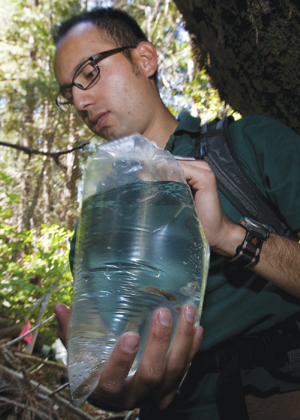No imminent move to Stage 3, Lynch assures directors
Idyllwild Water District remains in Stage 2 because the May and July rains have helped its wells, General Manager Tom Lynch reported to the directors Wednesday night, Aug. 19.
“There is still no water in Foster Lake,” Lynch added. “But the Foster Lake wells are up a bit because of the summer rains.” He also thanked IWD customers for “continued frugal use of water.”
Although Foster Lake has been dry for nearly two years, Lynch reported that the state has told IWD to prepare an emergency action plan in case the dam were to fail. Consequently, he is reviewing all of the emergency plans and combining them into one document.
Looking to the fall, Lynch reported on the recent announcements about possible arrival of an El Niño condition, but added, “There is no guarantee that this will be an El Niño year.”
In response to a question from Director John Cook regarding recent litigation over water fees in another county, Lynch said, “We are working on that impact if we move into Stage 3. We’ll refine an economic analysis to see if costs are consistent with the cost of production.”
The project to replace several hundred feet of effluent line is complete, he reported. “It was under budget and ahead of schedule,” Lynch said.
After Lynch mentioned that the staff was preparing a business plan for the district’s operation, Cook said, “Tom presented an outline of the business plan and I was very impressed. When it’s done, we’ll have a business plan we can rely on.”
During the public comment period, Pine Cove resident Marge Muir, who owns property in IWD, asked the board to consider permitting property owners to store water on site in case of fire emergencies and in compliance with regulations regarding sprinklers.
“There are some places, without a water district, where people are building new homes that comply with the new sprinkler for fire regulations,” she urged the board.
In general, the response was that it would depend upon the fire department’s approval, but Director Warren Monroe urged Lynch to investigate the option, since it might permit some property owners to avoid increasing their meter size (and, therefore, monthly water bills).
In water business, IWD used 6.8 million gallons of water in July, a 300,000-gallon increase over June. However, that was 2.9 million gallons (30 percent) less than July 2014.
Even with the tremendous conservation effort, water revenues in July were $112,000, actually $1,000 greater than July 2014. While usage will drop in the winter, IWD has already earned 15 percent of its projected total water sales revenue in one month.
Every rate category reduced usage, led by a greater-than 40-percent reduction from residential users. Reduction in the other categories ranged from 10 to 25 percent.
A year ago, IWD changed its billing policy to lower the level of water for which customers did not pay a usage fee. Rather than including the first 3,740 gallons used each month in a flat fee, IWD lowered that level to 1,870 gallons.
Consequently, revenues are supported by payments for the next 1,870 gallons now.







